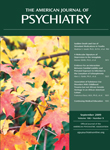Influence of Socioeconomic Status on Delusional-Like Experiences in Adults
To the Editor: I read with great interest the article by James Scott, M.B.B.S., F.R.A.N.Z.C.P., et al. (1) , published in the May 2009 issue of the Journal . Importantly, Scott et al. showed that measures of psychopathology identified at ages 5 and 14 years predict delusional beliefs at age 21. Although previous cross-sectional studies have documented such a relationship (2) , this is one of few longitudinal studies in the area.
In order to minimize the effect of potential confounding variables, the authors made adjustments for gender, age, and substance use. After doing so, statistical relationships remained significant. The authors also appear to have collected data from the study cohort on a number of additional relevant demographic variables, such as education and marital status. However, they did not examine the effects of these variables on the relationship between childhood psychopathology and adult delusions but rather explored the effects of these variables on missing data.
In my view, a number of these demographic variables may be relevant to the data described in the article. In particular, variables that relate to socioeconomic status may be important. Research suggests that low socioeconomic status is related to both behavior problems in childhood (3) and later schizophrenia (4) . It is plausible that the relationships observed by Scott et al. could be moderated or mediated by socioeconomic variables. For example, being from a low socioeconomic background could increase the risk of both childhood psychopathology and adult psychosis independently. Thus, controlling for socioeconomic variables may influence the effect size of such relationships. In addition, it would be interesting to examine the effect sizes of relationships in low versus high socioeconomic subsets comparatively.
I am unsure exactly what, if any, additional data on socioeconomic variables the authors hold for the study cohort. However, if they do hold such data, examining the effects of socioeconomic status would bring new insight into the important relationships observed in their article, which does state that “understanding the biological and psychosocial factors that influence this developmental trajectory may provide clues into the pathogenesis of psychotic-like experiences” ( 1 , p. 567).
1. Scott J, Martin G, Welham J, Bor W, Najman J, O’Callaghan M, Williams G, Aird R, McGrath J: Psychopathology during childhood and adolescence predicts delusional-like experiences in adults: a 21-year birth cohort study. Am J Psychiatry 2009; 166:567–574Google Scholar
2. Muratori F, Salvadori F, D’Arcangelo G, Viglione V, Picchi L: Childhood psychological antecedents in early onset schizophrenia. Eur Psychiatry 2005; 20:309–314Google Scholar
3. Kahn RS, Wilson K, Wise PH: Intergenerational health disparities: socioeconomic status, women’s health conditions, and child behavior problems. Pub Health Rep 2005; 120:399–408Google Scholar
4. Werner S, Malaspina D, Rabinowitz J: Socioeconomic status at birth is associated with risk of schizophrenia: population-based multilevel study. Schizophr Bull 2007; 33:1373–1378Google Scholar



